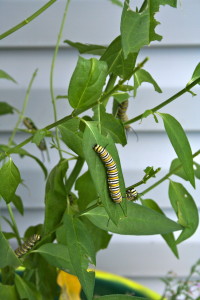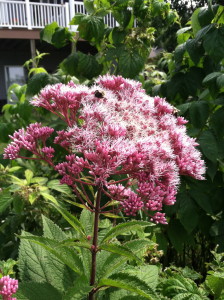Last weekend, I had a chance to speak at the Duluth Garden and Flower Society (MSHS District 8) Spring Luncheon in Duluth. The luncheon attracted about 80 enthusiastic gardeners from Duluth, the North Shore and the Iron Range. It was a fun event and I was honored to be asked to talk about MSHS, Northern Gardener and gardening trends.
One of the host groups was the local chapter of Wild Ones, a national group that promotes environmentally sound landscaping practices to preserve biodiversity. Wild Ones does a lot to educate and encourage the public about planting nature-friendly landscapes, including Monarch Way Stations. Wild Ones will even certify a garden space as a way station, if you provide what monarchs (and other pollinators) need. Whether you get your garden certified or not, it’s a good idea to learn about what it takes to attract pollinators. I decided to do a little inventory of how my own garden stacks up.
Larval plants: Monarch caterpillars require milkweed to grow into butterflies. It is their only food source. Wild Ones recommends having two types of milkweed in your landscape. I have lots (and lots!) of common milkweed on and near my property, but I think that is the only type. I’ll be looking this spring for either seeds or plants for swamp milkweed or prairie milkweed, both of which would do well in different parts of my landscape.
Early, mid and late food sources: Of the six early necatar plant shrubs Wild Ones recommends, I have one (serviceberry) in my yard, but there is pussy willow in the ponds near here. Of the eight recommended early forbs, I’ve got three (lupine, beardtongue and phlox). Not bad on early plants, but it could be better. Of the 36 shrubs, vines and perennials recommended for Monarchs for midsummer, my landscape has nine—again, not bad, could be better. Of the 10 plants recommended for late summer, I have three (goldenrod, aster and ironweed). Here’s the list of plants, in case you would like to see how favorable your landscape is for Monarchs.
Other landscape features to include for Monarchs include:
- No pesticide use
- Grasses (I have lots of those)
- One or more water source, such as a birdbath or a puddling spot
- Let things go a bit in the fall. Do not be quick to clean up flower stalks, grasses or leaves that may provide overwintering sites for beneficial insects.
How welcoming is your landscape for Monarchs and other pollinators?



These are great points. I don’t have a birdbath or puddling spot, so that might be something I will have to invest in if I want Monarchs to visit my garden. Thanks for sharing!